Finding Stationary Points: Video Lesson
What are Stationary Points?
Stationary points are the points on a function where its derivative is equal to zero. At these points, the tangent to the curve is horizontal. Stationary points are named this because the function is neither increasing or decreasing at these points. There are 3 types of stationary point: maxima, minima and stationary inflections.
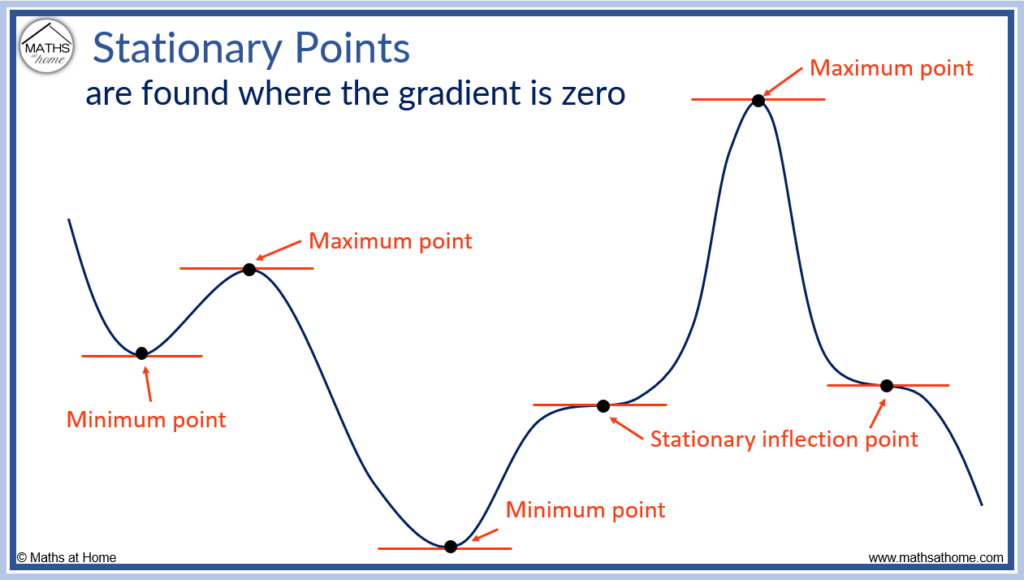
- A maximum point is a turning point where the curve is concave up (∩-shaped).
- A minimum point is a turning point where the curve is concave down (∪-shaped).
- A stationary inflection point is a point on the curve where the curvature changes and the tangent at this point is horizontal.
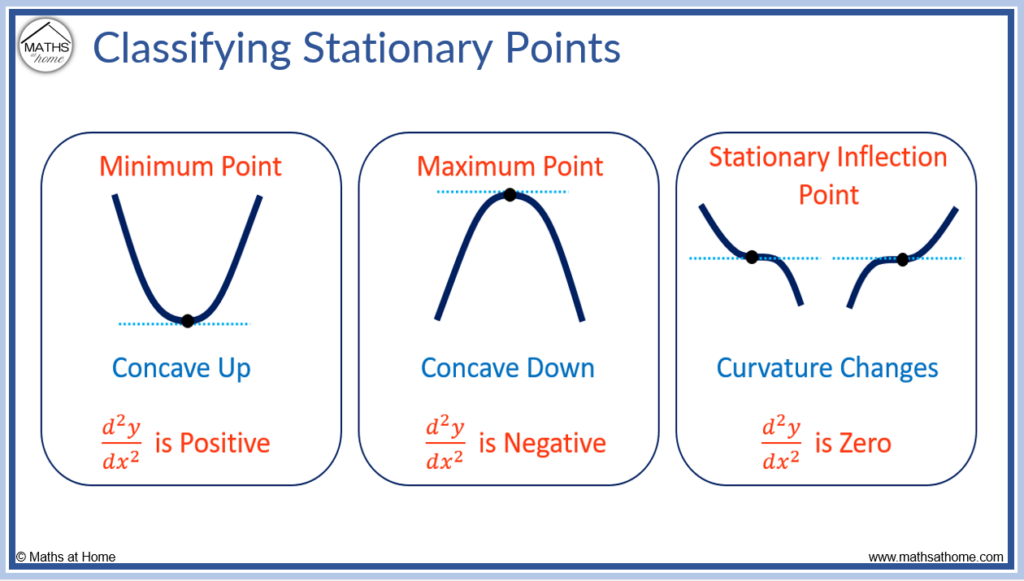
Turning points are points on a function where it turns around. That is, the graph changes from increasing to decreasing or vice versa. There are two types of turning point: a maximum point where the function changes from increasing to decreasing, or a minimum point where the function changes from decreasing to increasing.
Stationary points refer to any point where the derivative is zero. There are three types of stationary point: maxima, minima and stationary inflections. Turning points are where the function changes derivative. All turning points (maxima or minima) are types of stationary points. Inflection points are stationary points but they are not turning points.
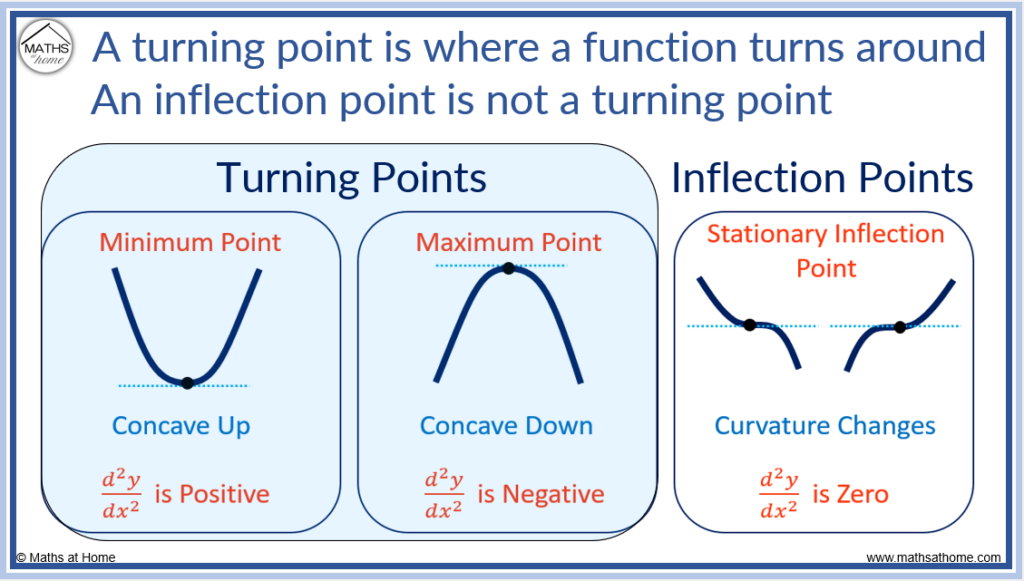
How to Find Stationary Points
To find stationary points:
- Differentiate the function.
- Set this derivative equal to zero.
- Solve for 𝑥.
- Substitute the 𝑥 coordinates back into the function to find the y coordinates.
For example, find the stationary point of y = 𝑥2 – 2𝑥 + 2.
Step 1. Differentiate the function
The derivative tells us the gradient.
Step 2. Set this derivative equal to zero
Stationary points are the locations where the gradient is equal to zero.
0 = 2𝑥 – 2
Step 3. Solve for 𝑥
We add two to both sides to get 2 = 2𝑥.
Dividing both sides by 2 we get 𝑥 = 1.
Step 4. Substitute the 𝑥 coordinate back into the function to find the y coordinate
When 𝑥 = 1, the function y = 𝑥2 – 2𝑥 + 2 becomes:
y = (1)2 – 2(1) + 2. Evaluating this, we get:
y = 1

The coordinates of the stationary point are found at 𝑥 = 1, y = 1.
This is written as (1, 1).
Stationary Points of a Quadratic
A quadratic equation always has one stationary point. If the quadratic has a positive coefficient of 𝑥2 then it is concave up and the stationary point will be a minimum point. If the coefficient of 𝑥2 is negative, the quadratic is concave down and the stationary point will be a maximum point.
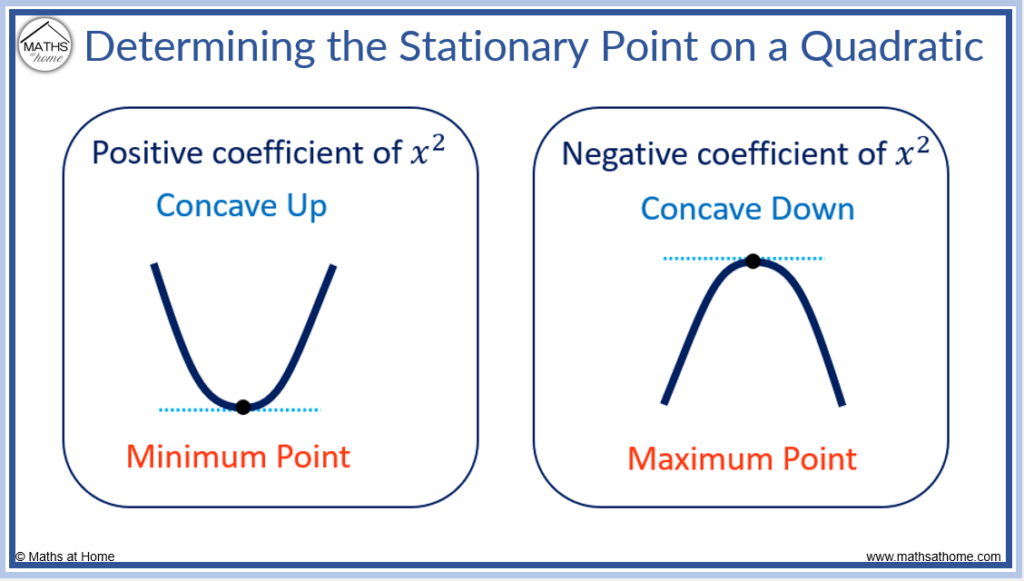
The stationary point on a quadratic is either a maximum point or a minimum point depending on the coefficient of 𝑥2.
A positive coefficient of 𝑥2 will always result in a minimum point. For example, the quadratic y = 𝑥2 – 3𝑥 – 1 has an 𝑥2 coefficient of 1 and since 1 is a positive number, the stationary point is a minimum point.
A negative coefficient of 𝑥2 will always result in a maximum point. For example, the quadratic y = -2𝑥2 + 5𝑥 + 3 has an 𝑥2 coefficient of -2 and since -2 is a negative number, the stationary point is a maximum point.
For any quadratic written in the form y = a𝑥2 + b𝑥 + c, the stationary point is always found at the point with an 𝑥 coordinate of 𝑥 = -b/2a.
For example, the quadratic y = 𝑥2 – 4𝑥 + 3 has a values of a = 1, b = -4, c = 3.
𝑥 = -b/2a tells us that the stationary point is found at 𝑥 = 4/2 at 𝑥 = 2.
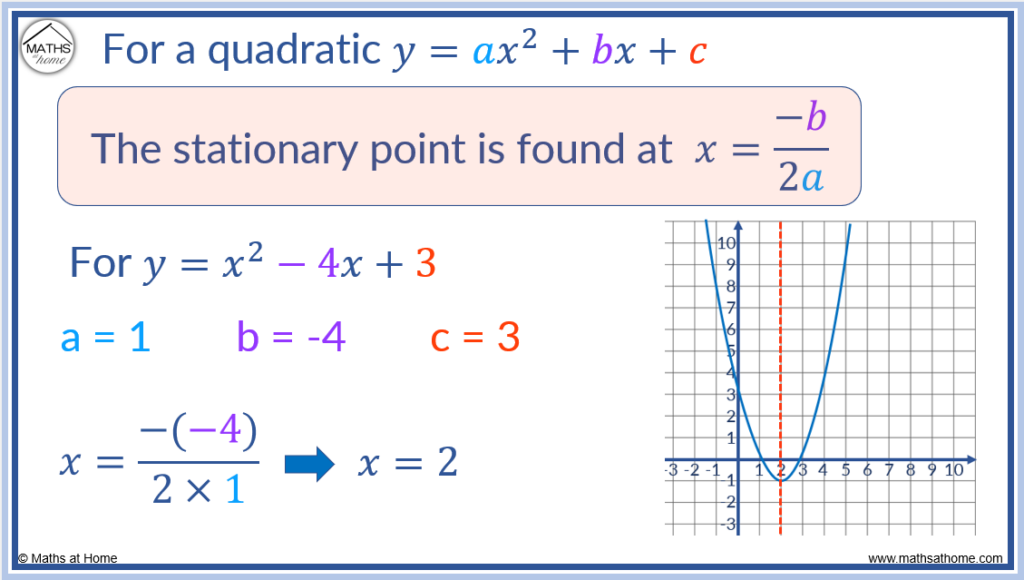
Stationary points on quadratics can also be found by completing the square.
To find the stationary point of a quadratic, first complete the square to write the quadratic in the form y = (x + a)2 + b. The coordinates of the stationary point can then be read from this form as (-a, b). For example, if y = (x – 2)2-1, the coordinates of the stationary point are (2, -1).
To complete the square for a quadratic of the form a𝑥2 + b𝑥 + c:
- Divide b by 2.
- Write this value added to 𝑥 inside a bracket.
- Write this bracket to the power of 2.
- Square the value from step 1 and subtract it from this bracket.
- Add c to this.
So for y = 𝑥2 – 4𝑥 + 3 where a = 1, b = -4 and c = 3:
- b ÷ 2 becomes -4 ÷ 2 which equals: -2.
- We write this added to 𝑥 as: (𝑥 – 2)
- We write this bracket to the power of 2 as: (𝑥 – 2)2
- Squaring the -2 from step 1, we get 4. Subtracting this we get: (𝑥 – 2)2 – 4
- We add c to this. Here c = 3 and so we get (𝑥 – 2)2 – 1

Since y = (𝑥 – 2)2 – 1, the stationary point is at (2, -1).
The 𝑥 coordinate of the stationary point is the value of 𝑥 that makes the bracket equal zero. Since the inside of the bracket is (𝑥 – 2), the stationary point is when 𝑥 = 2.
The y coordinate of the stationary point is the constant term that is next to the bracket. This is y = -1.
Stationary Points of a Cubic
Stationary points of cubic functions are found by differentiating the cubic and finding the values of x for which the resulting quadratic is equal to zero. If the cubic has a positive coefficient of x3, the function will have a maximum first then a minimum. If the coefficient is negative, the cubic will have a minimum first then a maximum.

In this example we will calculate the stationary points of y = 𝑥3 + 6𝑥2 + 9𝑥 + 4.
Step 1. Differentiate the function.
Step 2. Set the derivative equal to zero
Step 3. Solve for x
Each term can be divided by 3:
This can be factorised to get: 0 = (𝑥 + 1)(𝑥 + 3)
To solve, find the values of 𝑥 that make each bracket equal zero.
We get 𝑥 = -1 and 𝑥 = -3.
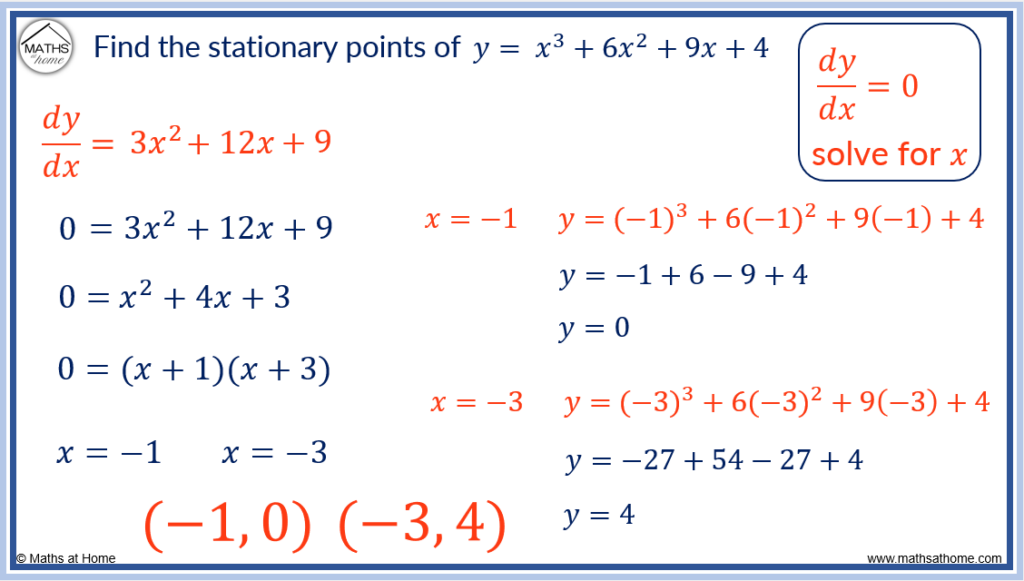
Step 4. Substitute the x coordinates into the function to find the y coordinates
When 𝑥 = -1, y = 𝑥3 + 6𝑥2 + 9𝑥 + 4 is equal to 0.
There is a stationary point at (-1, 0).
When 𝑥 = -3, y = 𝑥3 + 6𝑥2 + 9𝑥 + 4 is equal to 4.
There is a stationary point at (-3, 4).
To determine the nature of the stationary points of a cubic, consider the coefficient of 𝑥3.
In this example, the coefficient is equal to 1. This is a positive number and so, the stationary points are in the order of maximum and then a minimum. The order is dependent on their 𝑥 coordinate values.
Therefore ( -1, 0) is a maximum point and (-3, 4) is a minimum point.
Stationary Points of sin(x)
To find the stationary points of the sin(x) function, differentiate it to get cos(x). Then set this derivative to zero and solve for x. The cos(x) function is equal to zero at x = π/2 and x = 3π/2 in the interval 0≤x≤2π. Since sin(x) is periodic, further stationary points are found by adding or subtracting multiples of 2π from these values.
- sin(x) has a maximum point at
- sin(x) has a minimum point at
How to Determine the Nature of Stationary Points
The nature of any stationary point can be determined by substituting the x coordinate of the stationary point into the second derivative of the function, f”(x). If this value of f”(x) is negative, the stationary point is a maximum. If the value of f”(x) is positive, the stationary point is a minimum. If f”(x) is zero, it is a stationary inflection point.
There are 3 different types of stationary point.
The second derivative which can be written as either or
describes the curvature of the function.
Positive curvature values result in concave up functions. Any stationary point found here is a minimum.
Negative curvature values result in concave down functions. Any stationary point found here is a maximum.
The curvature changes when the second derivative is zero. This means that we have a point of inflection.

For example, use the second derivative to determine the nature of the stationary points on the curve .
The stationary points are found by differentiating the function to get and then finding the values of 𝑥 for which this derivative is zero. The stationary points are found at 𝑥 = -1 and 𝑥 = -3.
To classify the stationary points, we substitute the 𝑥 coordinates of the stationary points into the second derivative.
To find the second derivative, differentiate .
The second derivative, .
Substituting 𝑥 = -1 into the second derivative we get 6(-1) + 12 = 6.
6 is a positive result. A positive value for the second derivative tells us that the stationary point is a minimum point.
Substituting 𝑥 = -3 into the second derivative we get 6(-3) + 12 = – 6.
-6 is a negative result. A negative value for the second derivative tells us that the stationary point is a maximum point.

It does not matter what the size of the second derivative is, only its sign. It only matters whether the second derivative is positive, negative or zero.
How to Determine the Nature of Stationary Points Using the First Derivative
To determine the nature of a stationary point using the first derivative, evaluate the sign of the first derivative either side of the stationary point. When the derivative changes from positive to negative, the point is a maximum. If the change is negative to positive, the point is a minimum. There is no change for a stationary inflection point.

The following table shows how the change in the first derivative determines the nature of a stationary point.
| First Derivative Sign Diagram | Nature of Stationary Point |
| + / – | Maximum Point |
| – / + | Minimum Point |
| + / + or – / – | Stationary Inflection Point |
For example, classify the stationary points of y = 𝑥3 + 6𝑥2 + 9𝑥 + 4 using the first derivative.
The first derivative is found by differentiating the function.
The stationary points are found as the values of 𝑥 where this derivative equals zero.
There are stationary points at 𝑥 = -1 and 𝑥 = -3.
These values are marked on a sign diagram as shown on the right of the image below.
Values of 𝑥 are then substituted into the first derivative to find the sign of the first derivative in each region.
For values of 𝑥 less than -3, the first derivative is positive. (E.g. 𝑥 = -10, the first derivative is 189).
For values of 𝑥 between -3 and -1, the first derivative is negative. (E.g. 𝑥 = -2, the first derivative is -3).
For values of 𝑥 greater than -1, the first derivative is positive. (E.g. 𝑥 = 0, the first derivative is 9).
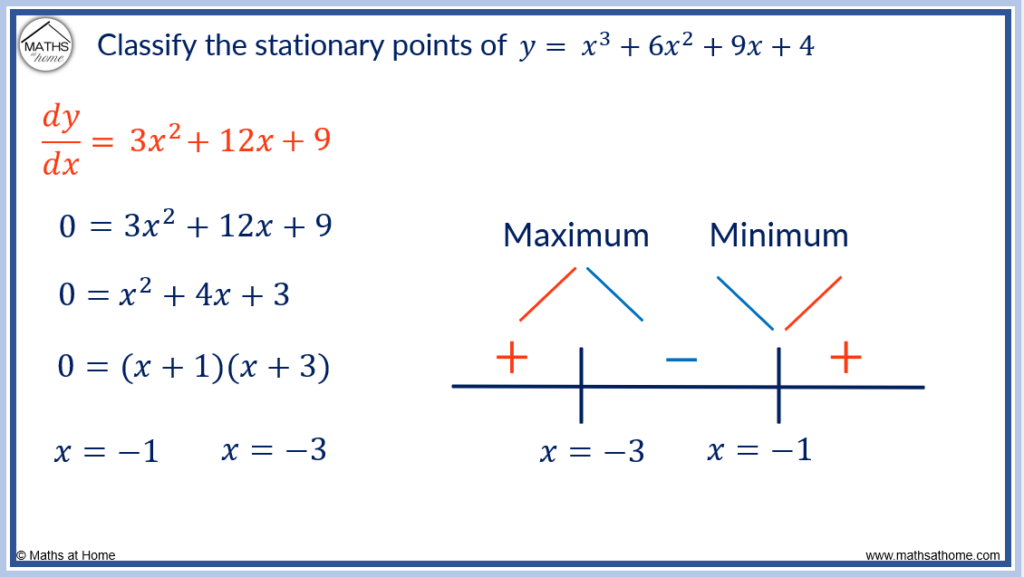
At 𝑥 = -3, the sign of the first derivative changes from positive to negative. The graph changes from going up to going down. The sign diagram here is + / -.
There is a maximum point at 𝑥 = -3.
At 𝑥 = -1, the sign diagram of the first derivative changes from negative to positive. The graph changes from going down to going up. The sign diagram here is – / +.
There is a minimum point at 𝑥 = -1.
How Many Stationary Points Does a Function Have?
A polynomial of degree n will have at most n-1 stationary points. If this function has no repeated roots and no stationary inflection points, it will have n-1 turning points. For every stationary inflection point that these polynomials contain, subtract 3 from its degree to find the number of turning points it has.
The table below shows the maximum number of stationary points that a polynomial can have.
| Degree of Polynomial | Type of Polynomial | Maximum Number of Stationary Points |
| n | 𝑥n | n-1 |
| 0 | Constant Term | 0 |
| 1 | Linear | 0 |
| 2 | Quadratic | 1 |
| 3 | Cubic | 2 |
| 4 | Quartic | 3 |
| 5 | Quintic | 5 |
The table below states the number of turning points a given polynomial can have.
| Degree of Polynomial | Type of Polynomial | Number of Turning Points |
| 0 | Constant Term | 0 |
| 1 | Linear | 0 |
| 2 | Quadratic | 1 |
| 3 | Cubic | 0 or 2 |
| 4 | Quartic | 1 or 3 |
| 5 | Quintic | 0, 2, 3 or 4 |
Some functions do not have stationary points.
If the derivative of a function cannot equal zero, there are no stationary points on the function. y = ex and y= 1/x are examples of functions that do not have stationary points.
A cubic function does not have a stationary point if its derivative does not equal zero. The derivative of a cubic function is a quadratic. If this quadratic has a negative discriminant, the quadratic cannot equal zero and so, the cubic cannot have any stationary points.
For example, consider the cubic y = 𝑥3 + 𝑥2 + 𝑥.
The derivative is .
There are only stationary points where this derivative equals zero. However there are no solutions to .
We know this since the discriminant of the quadratic, b2 – 4ac, is negative.
a = 3, b = 2 and c = 1.
b2 – 4ac becomes 22 – 4 × 3 × 1 which equals -8.
A quadratic with a negative discriminant cannot equal zero and so, there are no stationary points on this cubic.
